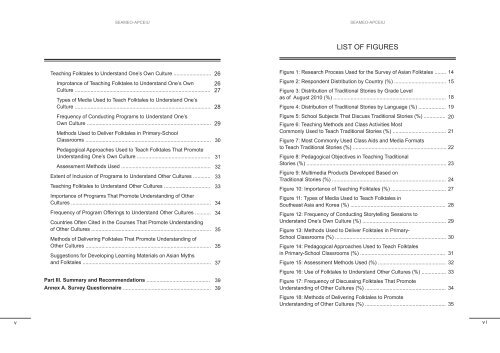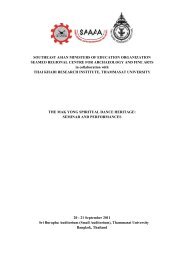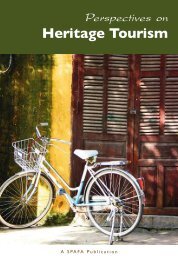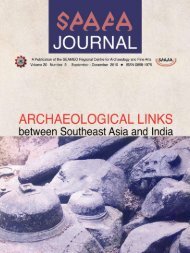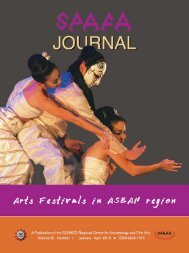SEAMEO-<strong>APCEIU</strong>SEAMEO-<strong>APCEIU</strong>LIST OF FIGURESTeaching Folktales to Underst<strong>and</strong> One’s Own Culture ..........................Improtance of Teaching Folktales to Underst<strong>and</strong> One’s OwnCulture ..............................................................................................Types of Media Used to Teach Folktales to Underst<strong>and</strong> One’sCulture ..............................................................................................Frequency of Conducting Programs to Underst<strong>and</strong> One’sOwn Culture ......................................................................................Methods Used to Deliver Folktales in Primary-SchoolClassrooms .......................................................................................Pedagogical Approaches Used to Teach Folktales That PromoteUnderst<strong>and</strong>ing One’s Own Culture ...................................................Assessment Methods Used ..............................................................Extent of Inclusion of Programs to Underst<strong>and</strong> Other Cultures ............Teaching Folktales to Underst<strong>and</strong> Other Cultures ................................Importance of Programs That Promote Underst<strong>and</strong>ing of OtherCultures .................................................................................................Frequency of Program Offerings to Underst<strong>and</strong> Other Cultures ...........Countries Often Cited in the Courses That Promote Underst<strong>and</strong>ingof Other Cultures ...................................................................................Methods of Delivering Folktales That Promote Underst<strong>and</strong>ing ofOther Cultures .......................................................................................Suggestions for Developing Learning Materials on <strong>Asia</strong>n Myths<strong>and</strong> Folktales .........................................................................................Part III. Summary <strong>and</strong> Recommendations ............................................Annex A. Survey Questionnaire .............................................................2626272829303132333334343535373939Figure 1: Research Process Used for the Survey of <strong>Asia</strong>n Folktales ........ 14Figure 2: Respondent Distribution by Country (%) .................................... 15Figure 3: Distribution of Traditional Stories by Grade Levelas of August 2010 (%) ..............................................................................Figure 4: Distribution of Traditional Stories by Language (%) ................... 19Figure 5: School Subjects That Discuss Traditional Stories (%) ...............Figure 6: Teaching Methods <strong>and</strong> Class Activities MostCommonly Used to Teach Traditional Stories (%) .....................................Figure 7: Most Commonly Used Class Aids <strong>and</strong> Media Formatsto Teach Traditional Stories (%) .................................................................Figure 8: Pedagogical Objectives in Teaching TraditionalStories (%) .................................................................................................Figure 9: Multimedia Products Developed Based onTraditional Stories (%) ...............................................................................Figure 10: Importance of Teaching Folktales (%) ...................................... 27Figure 11: Types of Media Used to Teach Folktales in<strong>Southeast</strong> <strong>Asia</strong> <strong>and</strong> <strong>Korea</strong> (%) ..................................................................Figure 12: Frequency of Conducting Storytelling Sessions toUnderst<strong>and</strong> One’s Own Culture (%) ..........................................................Figure 13: Methods Used to Deliver Folktales in Primary-School Classrooms (%) .............................................................................Figure 14: Pedagogical Approaches Used to Teach Folktalesin Primary-School Classrooms (%) ...........................................................Figure 15: Assessment Methods Used (%) ............................................... 32Figure 16: Use of Folktales to Underst<strong>and</strong> Other Cultures (%) ................. 33Figure 17: Frequency of Discussing Folktales That PromoteUnderst<strong>and</strong>ing of Other Cultures (%) ........................................................Figure 18: Methods of Delivering Folktales to PromoteUnderst<strong>and</strong>ing of Other Cultures (%) ........................................................182021222324282930313435vvi
SEAMEO-<strong>APCEIU</strong>SEAMEO-<strong>APCEIU</strong>LIST OF TABLESTable 1: Traditional Stories Found in <strong>Southeast</strong> <strong>Asia</strong>n <strong>and</strong> <strong>Korea</strong>n Primary-School Textbooks ........................................................................................Table 2: Programs for Underst<strong>and</strong>ing One’s Own Culture .......................... 26Table 3: Suggestions for Developing Learning Materials on <strong>Asia</strong>nMyths <strong>and</strong> Folktales ....................................................................................AEC<strong>APCEIU</strong>ASEANCCAPEIULao PDRMOESACLSEAMEOSEAMEO INNOTECHSEAMEO SPAFAUNUNESCOLIST OF ACRONYMSAssociation of <strong>Southeast</strong> <strong>Asia</strong>n Nations Economic Community<strong>Asia</strong>-Pacific Centre of Education for International Underst<strong>and</strong>ingAssociation of <strong>Southeast</strong> <strong>Asia</strong>n NationsCross-Cultural Awareness ProgramEducation for International Underst<strong>and</strong>ingLao People’s Democratic RepublicMinistry of EducationSociety for the Advancement of Children’s Literature<strong>Southeast</strong> <strong>Asia</strong>n Ministers of Education Organization<strong>Southeast</strong> <strong>Asia</strong>n Ministers of Education OrganizationRegional Center for Educational Innovation <strong>and</strong>Technology<strong>Southeast</strong> <strong>Asia</strong>n Ministers of Education OrganizationRegional Center for Archaeology <strong>and</strong> Fine ArtsUnited NationsUnited Nations Educational, Scientific, <strong>and</strong> Cultural Organization1635PART I. PROJECT AT A GLANCEThe <strong>Asia</strong>-Pacific Centre of Education for International Underst<strong>and</strong>ing (<strong>APCEIU</strong>) wasestablished as a United Nations Educational, Scientific, <strong>and</strong> Cultural Organization(UNESCO) Category II Institute in 2000, the year the United Nations (UN) proclaimedas the “International Year for the Culture of Peace.” The center’s chief m<strong>and</strong>ate is topromote Education for International Underst<strong>and</strong>ing (EIU) toward a culture of peacein the <strong>Asia</strong>-Pacific region. In accordance with the UNESCO Recommendation ConcerningEIU, Cooperation, <strong>and</strong> Peace <strong>and</strong> Education Relating to Human Rights <strong>and</strong>Fundamental Freedoms (1974) <strong>and</strong> the Declaration <strong>and</strong> Integrated Framework ofAction on Education for Peace, Human Rights, <strong>and</strong> Democracy (1995), <strong>APCEIU</strong> hasbeen carrying out a series of programs <strong>and</strong> activities ranging <strong>from</strong> training workshopsto the development of educational resources.To pursue its mission, <strong>APCEIU</strong> places a strong emphasis on a pedagogical approachto EIU. This approach integrates knowledge <strong>and</strong> underst<strong>and</strong>ing with the developmentof values <strong>and</strong> attitudes underpinning a culture of peace. The conceptualframework of EIU encompasses peace, human rights, intercultural underst<strong>and</strong>ing,<strong>and</strong> sustainability in a holistic manner.Meanwhile, the <strong>Southeast</strong> <strong>Asia</strong>n Ministers of Education Organization (SEAMEO)was founded in 1965 as a chartered regional organization m<strong>and</strong>ated to promotecooperation in education, science, <strong>and</strong> culture in the <strong>Southeast</strong> <strong>Asia</strong>n region. Theorganization’s core mission is to enhance regional underst<strong>and</strong>ing, cooperation, <strong>and</strong>unity of purpose among its member countries <strong>and</strong> to achieve a better quality of lifethrough the establishment of networks <strong>and</strong> partnerships, through the provision ofan intellectual forum for policy makers <strong>and</strong> experts, <strong>and</strong> through the promotion ofsustainable human resource development.The SEAMEO-<strong>APCEIU</strong> Collaboration on the Development of Learning Materials on<strong>Asia</strong>n Folktales marks the commitment of the two organizations to enhance <strong>Asia</strong>’sdiversity by developing a learning resource based on the folktales of <strong>Southeast</strong> <strong>Asia</strong><strong>and</strong> <strong>Korea</strong>. Guided by <strong>APCEIU</strong>’s m<strong>and</strong>ate to strengthen national <strong>and</strong> regional capacitiesin EIU <strong>and</strong> SEAMEO’s vision to implement “quality education for all” withinthe <strong>Southeast</strong> <strong>Asia</strong>n region, this initiative aims to increase intercultural educationbetween <strong>Southeast</strong> <strong>Asia</strong> <strong>and</strong> <strong>Korea</strong> by investigating regional folklores <strong>and</strong> folktalesfound in the primary-school textbooks of 12 <strong>Asia</strong>n countries.It is worth noting that this joint undertaking supports the Association of <strong>Southeast</strong><strong>Asia</strong>n Nations (ASEAN) Vision 2015, a roadmap for regional integration that aspiresto establish a political, economic, <strong>and</strong> sociocultural community in <strong>Southeast</strong> <strong>Asia</strong>within the next five years. Some of the specific priority objectives outlined in thisregional blueprint include the cultivation of a stronger sense of <strong>Southeast</strong> <strong>Asia</strong>nidentity <strong>and</strong> the strengthening of education <strong>and</strong> cooperation between the ASEANbloc <strong>and</strong> East <strong>Asia</strong>n countries such as <strong>Korea</strong>.vii1


